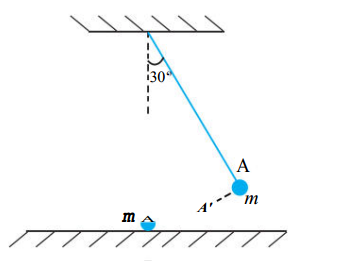Exercise from PSEB WORK, ENERGY AND POWER for Class 11
| Class 11 | PHYSICS |
| Chapter | WORK, ENERGY AND POWER |
| PSEB | Exercise |
| Medium | English |
| Academic Year | 2023-2024 |
Question 9
The potential energy function for a particle executing linear simple harmonic motion is given by V{x) = kx2/2, wherek is the force constant of the oscillator. For k=0.5Nm−1, the graph of V[x) versus x is shown in Fig. 6.12. Show that a particle of total energy 1 J moving under this potential must ‘turn back’ when it reaches x =overset+- 2 m. View Solution
View SolutionQuestion 11
Answer the following :- Comets move around the sun in highly elliptical orbits. The gravitational force on the comet due to the sun is not normal to the comet’s velocity in general. Yet the work done by the gravitational force over every complete orbit of the comet is zero. Why ? View Solution
View SolutionQuestion 13
Answer the following :- In Fig. 6.13(i) the man walks 2 m carrying a mass of 15 kg on his hands. In Fig. 6.13(ii), he walks the same distance pulling the rope behind him. The rope goes over a pulley, and a mass of 15 kg hangs at its other end. In which case is the work done greater ? View Solution
View SolutionQuestion 27
A body constrained to move along the z-axis of a coordinate system is subject to a constant force F given by F=−ˆi+2ˆj+3ˆkN where ˆi,ˆj,ˆk are unit vectors along the x-, y- and z-axis of the system respectively. What is the work done by this force in moving the body a distance of 4 m along the z-axis ?View SolutionQuestion 28
An electron and a proton are detected in a cosmic ray experiment, the first with kinetic energy 10 keV, and the second with 100 keV. Which is faster, the electron or the proton ? Obtain the ratio of their speeds, (electron mass = 9.11×10−31kg, proton mass = 1.67×l0−27kg, 1eV=1.60×10−19J)View SolutionQuestion 29
A rain drop of radius 2 mm falls from a height of 500 nr above the ground. It falls with decreasing acceleration (due to viscous resistance of the air) until at half its original height, it attains its maximum (terminal) speed, and moves with uniform speed thereafter. What is the work done by the gravitational force on the drop in the first and second half of its journey ? What is the work done by the resistive force in the entire journey if its speed on reaching the ground is 10ms−1 ?View SolutionQuestion 32
Two identical ball bearings in contact with each other and resting on a frictionless table are hit head-on by another ball bearing of the same mass moving initially with a speed V. If the collision is elastic, which of the following (Fig. 6.14) is a possible result after collision ? View Solution
View SolutionQuestion 35
A trolley of mass 300 kg carrying a sandbag of 25 kg is moving uniformly with a speed of 27km/h on a frictionless track. After a while, sand starts leaking out of a hole on the floor of the trolley at the rate of 0.05kgs−1. What is the speed of the trolley after the entire sand bag is empty ?View SolutionQuestion 41
A person trying to lose weight (dieter) lifts a 10 kg mass, one thousand times, to a height of 0.5 m each time. Assume that the potential energy lost each time she lowers the massis dissipated:- Fat supplies 3.8×107J of energy per kilogram which is converted to mechanical energy with a 20% efficiency rate. How much fat will the dieter use up?View Solution

